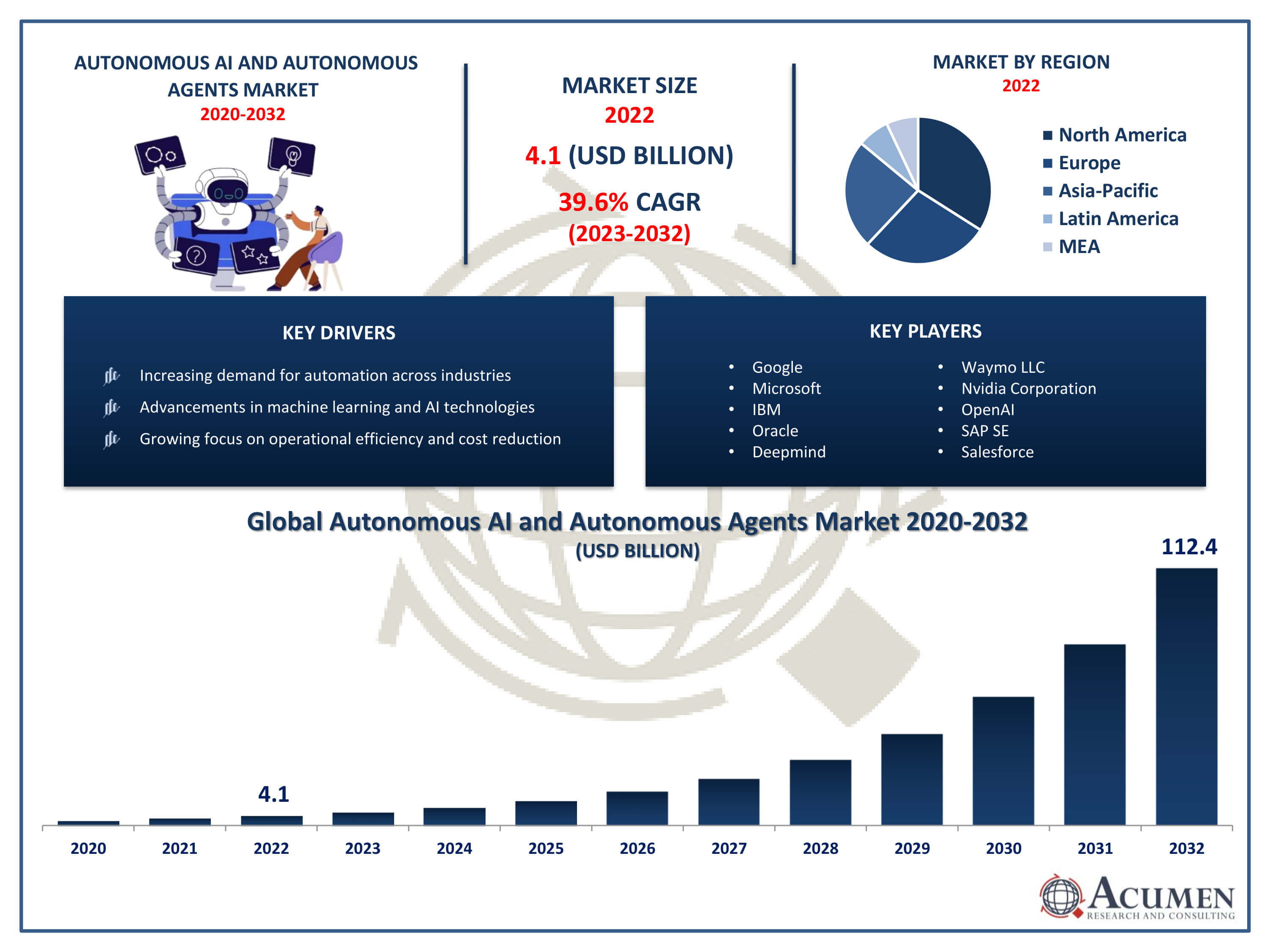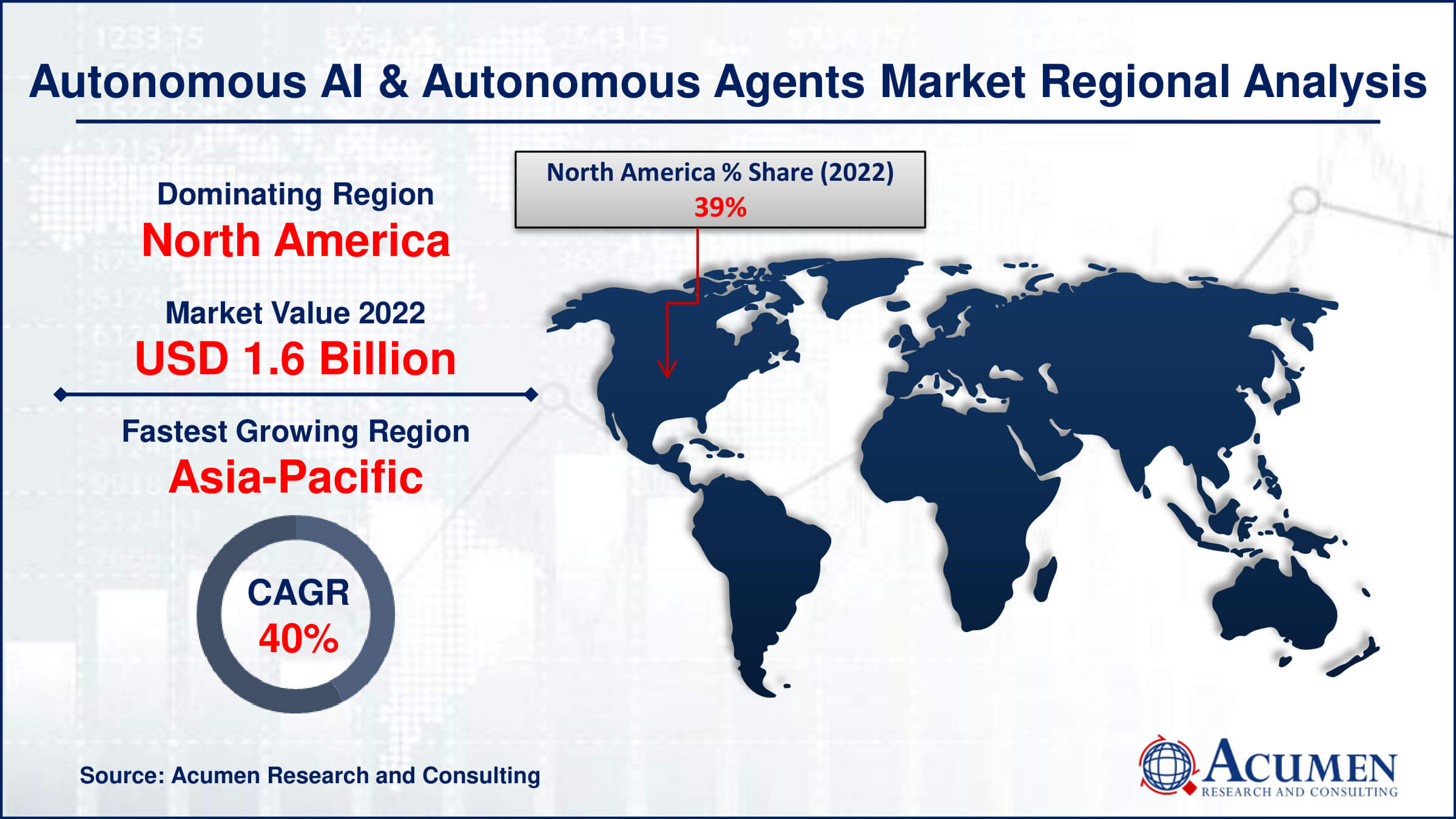The Autonomous AI and Autonomous Agents Market Size accounted for USD 4.1 Billion in 2022 and is projected to achieve a market size of USD 112.4 Billion by 2032 growing at a CAGR of 39.6% from 2023 to 2032.
Autonomous AI and Autonomous Agents Market Highlights
- Global autonomous AI and autonomous agents market revenue is expected to increase by USD 112.4 Billion by 2032, with a 39.6% CAGR from 2023 to 2032
- North America region led with more than 39% of autonomous AI and autonomous agents market share in 2022
- Asia-Pacific autonomous AI and autonomous agents market growth will record a CAGR of around 40% from 2023 to 2032
- By technology, the machine learning segment is the largest segment in the market, accounting for over 35% of the market share in 2022
- By deployment, the cloud segment has recorded more than 53% of the revenue share in 2022
- Increasing demand for automation across industries, drives the autonomous AI and autonomous agents market value
Autonomous AI refers to artificial intelligence systems or agents that can operate independently and make decisions without direct human intervention. These systems are designed to perform tasks or solve problems without continuous human oversight, utilizing machine learning algorithms, and often incorporating advanced technologies such as computer vision, natural language processing, and robotics. Autonomous AI can be found in various industries, including healthcare, transportation, finance, and manufacturing, where it offers the potential to enhance efficiency, reduce costs, and improve overall performance.
The market growth of autonomous AI and autonomous agents has been significant in recent years and is expected to continue expanding. The increasing demand for automation and the desire to optimize processes across industries are driving the adoption of autonomous AI solutions. In particular, sectors like autonomous vehicles, drones, and smart manufacturing are experiencing substantial growth. The rise of edge computing and the deployment of AI at the edge further contribute to the proliferation of autonomous agents. As the technology matures, businesses are recognizing the value of incorporating autonomous AI into their operations to gain a competitive edge, leading to a promising market outlook for autonomous systems in the coming years.
Global Autonomous AI and Autonomous Agents Market Trends
Market Drivers
- Increasing demand for automation across industries
- Advancements in machine learning and AI technologies
- Growing focus on operational efficiency and cost reduction
- Expansion of applications in autonomous vehicles and smart manufacturing
- Rise of edge computing and decentralized processing
Market Restraints
- Ethical and regulatory challenges in deploying autonomous systems
- Concerns about job displacement and societal impact
Market Opportunities
- Emerging applications in healthcare, agriculture, and logistics
- Integration of AI with Internet of Things (IoT) for enhanced functionality
Autonomous AI and Autonomous Agents Market Report Coverage
| Market | Autonomous AI and Autonomous Agents Market |
| Autonomous AI and Autonomous Agents Market Size 2022 | USD 4.1 Billion |
| Autonomous AI and Autonomous Agents Market Forecast 2032 | USD 112.4 Billion |
| Autonomous AI and Autonomous Agents Market CAGR During 2023 - 2032 | 39.6% |
| Autonomous AI and Autonomous Agents Market Analysis Period | 2020 - 2032 |
| Autonomous AI and Autonomous Agents Market Base Year |
2022 |
| Autonomous AI and Autonomous Agents Market Forecast Data | 2023 - 2032 |
| Segments Covered | By Component, By Technology, By Deployment, By End-use Industry, And By Geography |
| Regional Scope | North America, Europe, Asia Pacific, Latin America, and Middle East & Africa |
| Key Companies Profiled | Google, Microsoft, IBM, Oracle, Deepmind, Waymo LLC, Nvidia Corporation, OpenAI, SAP SE, and Salesforce. |
| Report Coverage |
Market Trends, Drivers, Restraints, Competitive Analysis, Player Profiling, Covid-19 Analysis, Regulation Analysis |
Autonomous AI and autonomous agent systems are designed to adapt to changing environments and circumstances, leveraging machine learning algorithms, sensor data, and advanced technologies. Autonomous agents, a subset of autonomous AI, are entities that can act on behalf of users or systems to accomplish specific goals. They are capable of perceiving their environment, reasoning about the information gathered, and making decisions to achieve objectives without direct human involvement. The applications of autonomous AI and agents span a wide range of industries. In autonomous vehicles, such as self-driving cars and drones, these technologies enable real-time decision-making based on environmental cues, contributing to safer and more efficient transportation. In manufacturing, autonomous agents facilitate smart automation by optimizing production processes, monitoring equipment, and enhancing overall operational efficiency.
The market for autonomous AI and autonomous agents is experiencing robust growth driven by technological advancements, increasing demand for automation, and the expansion of applications across various industries. As businesses strive to enhance operational efficiency and reduce costs, autonomous AI systems offer a compelling solution by automating tasks and decision-making processes. Industries such as manufacturing, transportation, healthcare, and finance are witnessing the integration of autonomous agents to streamline operations, improve productivity, and address complex challenges. One of the key drivers propelling market growth is the ongoing development of sophisticated AI technologies, including machine learning, computer vision, and natural language processing. These advancements enable autonomous agents to perform increasingly complex tasks and adapt to dynamic environments. Moreover, the rise of edge computing has facilitated the deployment of autonomous AI in decentralized settings, further contributing to the expansion of the market.
Autonomous AI and Autonomous Agents Market Segmentation
The global Autonomous AI and Autonomous Agents Market segmentation is based on component, technology, deployment, end-use industry, and geography.
Autonomous AI and Autonomous Agents Market By Component
- Hardware
- Services
- Software
According to the autonomous AI and autonomous agents industry analysis, the software segment accounted for the largest market share in 2022. The development and deployment of sophisticated algorithms, machine learning models, and software frameworks are key factors driving the expansion of this segment. Businesses across various industries are increasingly investing in AI software to enable autonomous agents to make informed decisions, process large volumes of data, and adapt to dynamic environments in real-time. One of the primary drivers of software segment growth is the continuous evolution of AI algorithms and deep learning techniques. These advancements empower autonomous agents to improve their learning and decision-making capabilities, making them more adept at handling complex tasks. Additionally, the growth of open-source AI frameworks and the availability of developer tools contribute to the accessibility and adoption of autonomous AI software.
Autonomous AI and Autonomous Agents Market By Technology
- Machine Learning
- Context Awareness
- NLP
- Computer Vision
In terms of technology, the machine learning segment is expected to witness significant growth in the coming years. Machine learning algorithms empower autonomous agents to analyze vast datasets, learn from experiences, and make data-driven decisions without explicit programming. As businesses seek to harness the potential of autonomous AI across diverse applications, the demand for machine learning technologies continues to surge, fostering innovation and advancement within the market. The growth of the machine learning segment is propelled by ongoing research and development initiatives, resulting in more sophisticated algorithms and models. These advancements enable autonomous agents to navigate complex scenarios, recognize patterns, and continuously improve their performance over time.
Autonomous AI and Autonomous Agents Market By Deployment
- Cloud
- On-premises
According to the autonomous AI and autonomous agents market forecast, the cloud segment is expected to witness significant growth in the coming years. This growth is driven by the increasing demand for scalable computing resources, storage, and seamless connectivity. Cloud computing provides a robust infrastructure for deploying and managing autonomous AI systems, allowing businesses to access the computational power necessary for training sophisticated machine learning models. As autonomous agents generate and process large volumes of data in real-time, the cloud offers a flexible and scalable solution, enabling organizations to efficiently store, analyze, and retrieve information while supporting the dynamic needs of these intelligent systems. The growth of the cloud segment is closely tied to the advantages it brings to the development and deployment of autonomous AI. Cloud services provide a cost-effective and agile environment for hosting machine learning models, enabling businesses to scale their operations without significant upfront investments in hardware.
Autonomous AI and Autonomous Agents Market By End-use Industry
- IT & Telecommunication
- BFSI
- Retail & E-commerce
- Manufacturing
- Government & Defense
- Healthcare & Lifesciences
- Others
Based on the end-use industry, the BFSI segment is expected to continue its growth trajectory in the coming years. This growth is driven by the industry's increasing reliance on advanced technologies to enhance customer experiences, streamline operations, and improve risk management. Autonomous AI is being leveraged in the BFSI sector to automate routine tasks, process large volumes of financial data, and provide personalized services to customers. Virtual assistants powered by autonomous agents are employed for customer interactions, facilitating tasks such as account inquiries, transaction processing, and fraud detection, ultimately leading to improved operational efficiency and cost savings. Machine learning algorithms and predictive analytics within autonomous AI are instrumental in the BFSI sector for credit scoring, risk assessment, and fraud prevention. These technologies enable financial institutions to make data-driven decisions, optimize lending practices, and enhance security measures.
Autonomous AI and Autonomous Agents Market Regional Outlook
North America
- U.S.
- Canada
Europe
- U.K.
- Germany
- France
- Spain
- Rest of Europe
Asia-Pacific
- India
- Japan
- China
- Australia
- South Korea
- Rest of Asia-Pacific
Latin America
- Brazil
- Mexico
- Rest of Latin America
The Middle East & Africa
- South Africa
- GCC Countries
- Rest of the Middle East & Africa (ME&A)
Autonomous AI and Autonomous Agents Market Regional Analysis
North America is dominating the autonomous AI and autonomous agents market due to a combination of factors that position the region at the forefront of technological innovation and adoption. The presence of leading technology companies, research institutions, and a mature ecosystem for artificial intelligence development contribute to North America's prominence in this market. Major tech hubs, such as Silicon Valley in the United States, host a concentration of talent, expertise, and investment that fosters the rapid development and deployment of autonomous AI technologies. Additionally, North America benefits from robust government initiatives and private sector investments that support the growth of autonomous AI. The United States, in particular, has been proactive in fostering innovation through policies, research funding, and collaboration between industry and academia. The region's early adoption of autonomous vehicles, smart cities initiatives, and integration of AI into various sectors, including healthcare and finance, further solidify its dominance. As industries across North America continue to embrace automation and AI-driven solutions for enhanced efficiency and competitiveness, the region is likely to maintain its leadership position in the global autonomous AI and autonomous agents market.
Autonomous AI and Autonomous Agents Market Player
Some of the top autonomous AI and autonomous agents market companies offered in the professional report include Google, Microsoft, IBM, Oracle, Deepmind, Waymo LLC, Nvidia Corporation, OpenAI, SAP SE, and Salesforce.
Frequently Asked Questions
The autonomous AI and autonomous agents market size was USD 4.1 Billion in 2022.
The CAGR of autonomous AI and autonomous agents is 39.6% during the analysis period of 2023 to 2032.
The key players operating in the global market are including Google, Microsoft, IBM, Oracle, Deepmind, Waymo LLC, Nvidia Corporation, OpenAI, SAP SE, and Salesforce.
North America held the dominating position in autonomous AI and autonomous agents industry during the analysis period of 2023 to 2032.
Asia-Pacific region exhibited fastest growing CAGR for market of autonomous AI and autonomous agents during the analysis period of 2023 to 2032.
The current trends and dynamics in the autonomous AI and autonomous agents industry include increasing demand for automation across industries, advancements in machine learning and AI technologies, and growing focus on operational efficiency and cost reduction.
The machine learning technology held the maximum share of the autonomous AI and autonomous agents industry.



